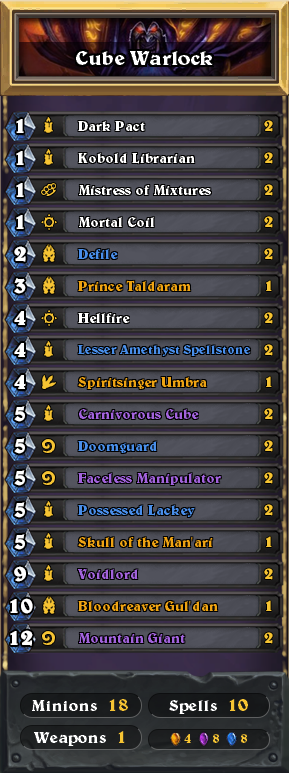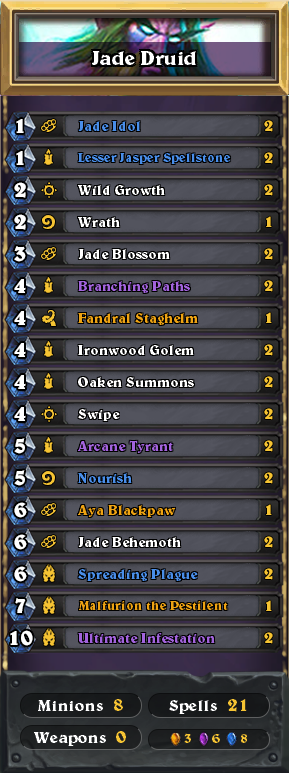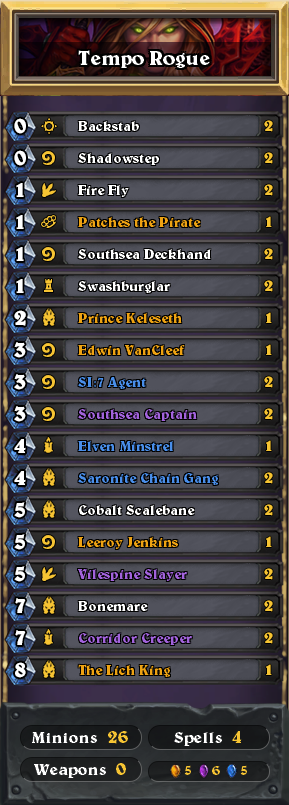 I just got back into town after attending the Hearthstone (Free) Championship in Amsterdam, and, man, there are few things better than watching that level of play. I read a lot of (very valid) criticism that it can be a little boring watching the same ol’ tournament meta, but I really appreciated watching decks like Jade Druid or Highlander Priest being played on a level that is nothing short of masterful. The Taiwanese player Tom60229 took home the championship, so for this week’s Hearthstone roundup we’re focusing on the four decks he played at the Hearthstone Championship Tour last weekend.
I just got back into town after attending the Hearthstone (Free) Championship in Amsterdam, and, man, there are few things better than watching that level of play. I read a lot of (very valid) criticism that it can be a little boring watching the same ol’ tournament meta, but I really appreciated watching decks like Jade Druid or Highlander Priest being played on a level that is nothing short of masterful. The Taiwanese player Tom60229 took home the championship, so for this week’s Hearthstone roundup we’re focusing on the four decks he played at the Hearthstone Championship Tour last weekend.
 Cube Warlock – Weighing in at a hefty 10,640 dust, Cube Warlock (or Cubelock) is an evolution on the classic control Warlock decks (sometimes called Demonlock). It has seen loads of play, and gets its name from one of the three cards that make up the winning combo: Carnivorous Cube, Skull of the Man’ari and Doomguard. Skull of the Man’ari is a weapon which summons a demon from your hand every turn, and ideally you want to use that to cheat out Doomguard’s without triggering Doomguard’s battlecry which involves discarding two cards from your hand. The deck also runs Possessed Lackey which recruits a demon from your deck, providing a second alternative to getting Doomguards into play.
Cube Warlock – Weighing in at a hefty 10,640 dust, Cube Warlock (or Cubelock) is an evolution on the classic control Warlock decks (sometimes called Demonlock). It has seen loads of play, and gets its name from one of the three cards that make up the winning combo: Carnivorous Cube, Skull of the Man’ari and Doomguard. Skull of the Man’ari is a weapon which summons a demon from your hand every turn, and ideally you want to use that to cheat out Doomguard’s without triggering Doomguard’s battlecry which involves discarding two cards from your hand. The deck also runs Possessed Lackey which recruits a demon from your deck, providing a second alternative to getting Doomguards into play.
Once you manage to get a Doomguard out without discarding, you use Carnivorous Cube which destroys the Doomguard, then by using Spiritsinger Umbra and Dark Pact along side Carnivorous Cube to get four Doomguards on board. Doomguards are charge minions too, so you can cheat out your Doomguard, attack, then attack again with your new Doomguards once the Carnivorous Cube does its thing. It’s an incredibly powerful combo that really just gets stupid in the late game when you play Bloodreaver Gul’dan, bringing all the Doomguards back again. Games don’t typically last that long, as if you can pull off the entire combo that’s 25 damage in one turn which provided you did a decent job at controlling the board state could all go directly to face.
Here’s a great video that shows how it all works:
 Highlander Priest – If you’ve watched any competitive Hearthstone being played, you’ve no doubt seen more matches involving Highlander Priest than you can even count. However, what you probably don’t know is where the deck got its name from. The cards that power the win condition in this deck require your deck to have no duplicates. Since there can only be one of each card, it’s a reference to the movie Highlander. Specifically, this quote. I first heard decks called this back in the Magic the Gathering days.
Highlander Priest – If you’ve watched any competitive Hearthstone being played, you’ve no doubt seen more matches involving Highlander Priest than you can even count. However, what you probably don’t know is where the deck got its name from. The cards that power the win condition in this deck require your deck to have no duplicates. Since there can only be one of each card, it’s a reference to the movie Highlander. Specifically, this quote. I first heard decks called this back in the Magic the Gathering days.
Anyway, the basic idea behind the deck is to get the game in a state where you’ve played Raza the Chained which reduces the cost of your hero power to zero mana, then getting Shadowreaper Anduin online to both clear any big threats from the battlefield as well as switching your hero power to Voidform which deals two damage instead of the typical Priest heal. Voidform can be cast over and over as it is refreshed with each new spell that is cast, which can result in massive end-game turns where you’re blasting cheap spells and hero power attacks over and over.
Early game, the deck plays very similar to many other Priest decks which focus on controlling the board to survive long enough to get the game in a state where you can Voidform your opponent to death. It’s a beefy deck coming in at 12,000 dust which runs six super crucial legendary cards as games can also be won by comboing Prophet Valen to double the damage of Mind Blast, potentially resulting in 20 damage to your face.
Highlander Priest sees so much play because it’s a deck that has answers to practically everything your opponent can play while having multiple powerful end-game win conditions. Of course, the deck is pretty pricy, but love it or hate it, it’s here to stay until more cards get introduced or something else happens to shake up the Hearthstone tournament meta.
While he isn’t playing the exact same deck, former Hearthstone champion Pavel put together a pretty great video late last year that shows the basic concepts that power Highlander Priest in action.
Check it out:
 Jade Druid – Much like Highlander Priest, if you’ve even vaguely paid attention to anything to do with competitive Hearthstone, or have even played a ranked game recently, you’ve no doubt seen Jade Druid. Playing the deck is actually pretty simple, as it has the basic goal of make huge Jade Golems, and eventually overwhelm your opponent through your ability to just constantly dump out bigger and bigger creatures.
Jade Druid – Much like Highlander Priest, if you’ve even vaguely paid attention to anything to do with competitive Hearthstone, or have even played a ranked game recently, you’ve no doubt seen Jade Druid. Playing the deck is actually pretty simple, as it has the basic goal of make huge Jade Golems, and eventually overwhelm your opponent through your ability to just constantly dump out bigger and bigger creatures.
Mastery of the deck, however, involves managing both the cards in your hand as well as making sure you’re using Jade Idol to keep cards in your deck for you to draw so you don’t end up killing yourself with fatigue damage. Aside from building Jades, Ultimate Infestation is your main tech card for getting loads of gas late game. You deal five damage, often removing a problem creature, draw five cards, typically giving you more Jades, and while you’re at it you gain five armor and summon a 5/5 duel. Overall, a super powerful card for ten mana.
Similar to the previous video, while Trump isn’t playing the exact same deck, he does a great job of explaining the thought process that goes into when to hold and play the different cards in your deck as well as how to not run out of Jade cards to play.
Take a look:
 Tempo Rogue – The last deck Tom60229 brought to the Hearthstone Championship Tour this year was Tempo Rogue. When playing tempo decks, the idea is to keep tempo throughout the game, starting with powerful low cost minions and eventually ramping up into massive threats. It’s not a new archetype by any stretch of the imagination, but recently it has become a mainstay in competitive play.
Tempo Rogue – The last deck Tom60229 brought to the Hearthstone Championship Tour this year was Tempo Rogue. When playing tempo decks, the idea is to keep tempo throughout the game, starting with powerful low cost minions and eventually ramping up into massive threats. It’s not a new archetype by any stretch of the imagination, but recently it has become a mainstay in competitive play.
Patches the Pirate plays a big role early game in getting ahead of your opponent with annoying amounts of early turn damage that comes from the pirates that are typically run in tempo rogue. From there, you play cards like Saronite Chain Gang which gives you some taunt protection to get into later turns where you can do things like soup up minions with Bonemare, cheaply play Corridor Creeper from cheap minions that have died before, or just summoning The Lich King himself.
Or, you can do what Tom60229 did in the championship match and just live the giant Edwin VanCleef dream, which is something aggro rogue decks have thrived on since the earliest days of Hearthstone. He gains +2/+2 for each card played before him, so by using the Coin, Backstab, Shadowstep, and other cheap/free cards you can get a absolutely massive minion in play.
Like the other decks listed in this article, this accompanying video isn’t exactly what was played at HCT, but Trump always does a great job at really breaking down how a deck works while he plays.
Give it a look:
To check out the rest of the decks played at the Hearthstone Championship last weekend, head over to Blizzard’s site which is where these deck list images are all from. We’ll have more coverage soon on the Hearthstone Championship Tour, as well as some interviews, but for now… I’m going to bed. A seven hour time change has my brain totally wrecked!